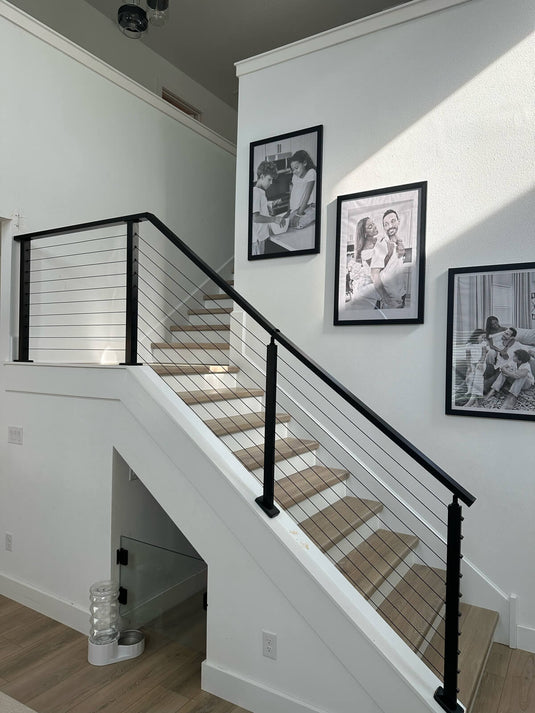TABLE OF CONTENTS
What to Consider When Installing Indoor Cable Stair Railing?
The popularity of cable railings in modern home designs continues to rise for good reason. These railings strike an ideal balance between aesthetics and functionality when installed on indoor stairs. Homeowners looking to replace dated railings or upgrade their staircase need to carefully consider key factors like safety, space optimization, interior design style, durability, lighting effects, customization, budget, installation, and overall home coordination. Taking the time to evaluate options against personal needs and priorities allows for an informed decision when choosing cable railings for this high-traffic area of the home.

Family Members and Safety
Protecting vulnerable household members from harm must remain a top priority when installing stair railings. For homes with toddlers, young children, pregnant mothers, or elderly residents, select only strict code-compliant railings meeting maximum child head entrapment allowances and hand gripability standards. Opt for a 3-inch maximum spacing between vertical barrier cables or infill panels to prevent slipping injuries, especially for unsteady little ones. Combine with tactile anti-slip stair nosing on tread edges for better footing security. Grip-friendly oval handrails properly recessed from walls also promote stability across all ages. Following these published safety guidelines reassures parents and caretakers that even playfully erratic stair navigation stays secure. That peace of mind liberates family enjoyment of beautiful yet responsibly safety-optimized railing selections.
Space Size and Layout
In compact stairwells, bulky railing components easily cramp already narrow passageways. Fortunately, cable systems’ slender profiles treat tight spots with simplicity. With just thin steel wires spanning discreet vertical posts, cable guard rails avoid compression of mid-sized staircases. Especially when accented with glass inserts or woven translucent mesh infill, negative space prevails. Homeowners seeking to preserve coveted functional territory in small footprints should strongly consider this barely-there approach. Traditional baluster spindle designs often require more space, which can reduce the available width of the passageway. But with strategic minimal use of barrier cables and posts, safety standards remain satisfactorily intact without overflow into adjoining circulation zones. Openness and free airflow also reduce feelings of confinement that disrupt cohesive home enjoyment for dwellers.
Interior Design Style
When selecting stair railings, ensure the style appropriately matches the home's overall aesthetic vision. For contemporary interiors with modern geometries and materials like concrete or metal, opt for sleek steel cable rails with ultra-slim supports to continue the clean visual lines. Contrast that modern industrial effect against more ornate wood species options like walnut or oak, which project traditional warmth even when integrating woven cable accents. Design styles fall along a spectrum, so identify priorities first before choosing railings. Historic restorations or traditional spaces need classic wood top rails with turned balusters or decorative metalwork for era-appropriate finishing touches. Transitional spaces can balance modern and traditional through hybrid mixed-media selections like combining wood caps with sleek metal cable infills. Thoughtfully matching stair railings to the intended decorative environment sets a consistent tone throughout the home.

Maintenance and Durability
All railings endure high-traffic exposure, so durability and weather resistance remain key priorities for longevity. Frequently gripped wood or metal elements require durable finishes that withstand moisture while resisting dents and scratches from daily handling. Stainless steel cables deliver strength and just need basic cleaning to maintain appearance despite decades of use. Certain wood types offer renewable refinishing capacity to refresh occasional aesthetic wear over long lifecycles. However, low-grade softwoods decay quicker from humidity and may require full replacement in less than ten years. Aluminum performs well, too if properly anodized and coated to prevent corrosion. When shopping options, request details on product ratings, warranty programs, and manufacturer-recommended care. Investing a bit more upfront in better quality materials prevents exponentially higher costs from frequent railing replacement just to maintain safety. This becomes especially worthwhile for homeowners planning longer tenancies.
Light and Visual Effects
Strategic railing design employs lighting and illusory depth tricks, expanding the perceived scope of the staircase. During daylight, translucent paneling or thinly spread cable strands encourage refreshing natural illumination without shadowy obstructions. Reflective metal finishes even amplify sunlight ingress. Come nightfall, integrated low-voltage LED handrail lights provide essential safety visibility. For smaller landings or taller runs, visual continuity also enhances openness through thin members that seemingly disappear. However, even these near-invisible profiles must meet child safety grasp and entry prevention standards. Further heightening depth, glass panels introduce see-through layers while mesh-woven infill maintains code-compliant fall protections. Applied correctly following guidelines, these astute optical enhancements widen claustrophobic stairwells through magical optical expansion.
Customization
Standard railing components rarely accommodate architectures beyond stacked stair runs. Customization liberates designers from getting creative in addressing distinctive spatial constraints. Multi-angle transitions along winding routes inspire intricately snaked cable paths bolted in place to frame unique geometries safely. Horizontal spreads open balcony-like platforms through asymmetric cable alignment versatility thanks to incrementally adjustable tension anchors. Color coordination with surrounding paint schemes prevents disjointed aesthetics, too, through accurately matched powder-coating. Beyond stock colors, custom mixed hues add personalization to any home decor vision. For households desiring one-of-a-kind stairwell focal points, bespoke cable materials, layouts, and finishes personalized to specialized installations gild otherwise overlooked spaces with artisanal beauty through custom-tailored forms meeting unique function.

Budget
Cable railings span a broad price spectrum, so defining budgetary limitations before shopping prevents sticker shock. Contractors specify high-tier 316-grade stainless steel systems resisting corrosion for upwards of $300 per linear foot installed. More affordable options like galvanized steel cables wrapped in protective zinc coatings provide code-approved protection at nearly half that. Though durable aluminum solutions cost less upfront, longevity concerns might require full replacement after less than a decade, depending on environmental exposures. Consider ongoing maintenance, too - wood needs frequent staining, while steel polishes easily. Determine total tenancy duration to calculate cost comparisons. While premium stainless steel requires higher initial cash outlay, it often pays dividends through decades of near-zero upkeep before outliving homes themselves. Alternatively, lower-grade cables suit shorter-term needs if move-out plans are less than ten years out.
Installation and Adjustability
Improper installations plague amateur DIY attempts at complicated cable railings. Mastering the calibrated tension balance between securely anchored posts and finely tuned stabilization cables requires professional expertise. True permanence relies on drilling into structural framing, so slipshod drywall anchors jeopardize safety even when following proper assembly procedures. Professionals also supply specialized tools for adjusting tension to code tolerances. This prevents dangerous slack but avoids over-tightening that strains connections to failure over years of use. Moreover, correctly gauged pilots accommodate natural settling shifts that routine re-adjustments seamlessly counteract. Only qualified stair contractors possess the specialized instruments and field experience required, ensuring the flexibility of non-destructive modifications if stairs or homes shift slightly between seasons. Factor these post-installation considerations before selecting seasoned railings teams for enduring safety.
Selecting the right indoor cable stair railing systems holds significance beyond simply enhancing staircase beauty. Key considerations around homeowner needs, safety, lighting, spatial functionality, and interior design themes ensure prudent decision-making. Cable systems provide excellent durability, customization potential, and design flexibility. However, homeowners must also evaluate their priorities and budget accordingly. Carefully weighing preferences with professional designer advice allows for fully informed choices on this impactful architectural upgrade that promises security and beauty for many years to come.




